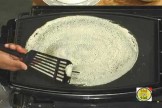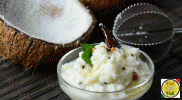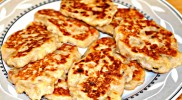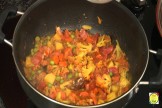Oatmeal cookies creates a moist and flavorful dessert that will make everyone's day a lit...

Dosa recipe - a small collection of basic dosa to masala dosa recipes from South Indian C...

Coconut chutney recipe is an easy and quick to make chutney which serves as a side dish f...

Banana dosai a speciality of festive occassion.Banana dosai is a sweet crepe/ Indian dosa...

A typical Maharashtrian style Kurma curry combined with mixed vegetables cooked in a spic...
Soup is a primarily liquid food, generally served warm. Chickpea soup with rice is a tast...
Samosa is one of the most popular appetizer or snack in India. these small samosas served in most of the Iranian Cafes in Hyderabad.
About Recipe
Ullipayalu pakodi Samosa, Onions Samosa recipe, Piyaz samuka Samosa |
|||||||||||||||||||||||||||||||||||||||||||
|
|||||||||||||||||||||||||||||||||||||||||||
Breakfast is also known as tiffin or nashta in various region of India. Breakfast or tiffin is definitely an essential meal particularly when you're on the health plan or weight loss plan. A fantastic, balanced tiffin is the ultimate way to get the metabolism functioning properly for the whole day.
After an 8 hours’ rest, everybody has to refuel themselves with higher quantity of proteins, nutrients and minerals etc. The modern day lifestyle is too hectic, stressed and hardly have enough time to give value to the most significant meal of the day. It's important to have nutritious, appetizing and yummy tiffin each morning which assists to control blood sugar levels through lunchtime, which plays an important role for your mood.
The Indian breakfast or tiffin menu isn't a one-size suits all as well as doesn't actually work perfectly into a daily calorie chart. It is dependent on the amount of energy one genuinely requires. So extra physical labor indicates a king-size breakfast. Traditional Indian tiffin is freshly cooked, generally veggie, served warm, usually delicious, spiced slightly as well as in small portions. There's a reason behind this style and the credit goes to traditional Ayurveda - the science of healthy life.
The ingredients of authentic Indian tiffin are available regionally and even seasonally. The naashta is always fresh and cooked - be it Stuffed Paratha in the North or Idlis, Pongal, Vada, Dosa, Upama etc in the South. In Maharashtra, Potato Poha, Upma, are the preferred breakfast. Gujarati breakfast items are Haandvo, Dhokla, Sev-Khamni, Theplas, Bhaakhri etc. Masala Tea is or filter Coffee are complementary. Children are always given Milk.
Benefits of having a healthy breakfast:
We have a wide variety of Indian Tiffin that you can eat to please your taste buds You can also be inventive and cook new options to suit your loved one's flavor and keep body and mind fit and steady. Some of the very popular Indian breakfast are Idli, Dosa, Upma, low fat Roti, Omlette, Sandwich, Poha, Dhokla, Thepla and so on.

Barbara Kelman Posted on Sat Jan 20 2018
I do not think i will live long enough to make and eat all of the wonderful food you prepare, but i am going to try :)
Reply 0 - Replies
Guest Posted on Sat Aug 13 2016
I tried most of ur recipe. If i have to prepare something special i see ur recipe only.My husband daughters& guest praise my cooking& the credit goes to u.
Reply 0 - Replies
Parvathy Cs Posted on Mon Dec 14 2015
thank you chef. all your recipes are nice. I've learnt a lot from you.?
Reply 0 - Replies
Daffodils Daphne Posted on Wed Dec 16 2015
you are a good chef!! thank you so much for sharing your recipes with every1. may God bless you?
Reply 0 - Replies
Tulika Karmakar Posted on Fri Dec 18 2015
Eat half a dozen samosas..... hahahaha... your love for food is unique and interesting :)?
Reply 0 - Replies

Vaishnavi Posted on Tue Dec 22 2015
Along with onions,can we stuff any other vegetables??
Reply 0 - Replies

Muzaffar Nazar A HR Coordinator Posted on Mon Dec 28 2015
sir g mind blowing,,, thnx for top secret sharing...?
Reply 0 - Replies
Akhil Dev Posted on Mon Jan 04 2016
your attitude towards food is like icing on the cake.....?
Reply 0 - Replies
Akhil Dev Posted on Mon Jan 04 2016
your attitude towards food is like icing on the cake.....?
Reply 0 - Replies Easy recipes
Easy recipes
 Healthy Recipes
Healthy Recipes
 Dessert Recipes
Dessert Recipes
 Mutton and Lamb
Mutton and Lamb  Indian Bread Recipes
Indian Bread Recipes
 Dal Recipes
Dal Recipes
 Chutney and Pickles
Chutney and Pickles  Indo-Chinese Recipes
Indo-Chinese Recipes
 Snacks and Appetizers
Snacks and Appetizers
 Low Fat Recipes
Low Fat Recipes
 Chaat Recipes
Chaat Recipes
 Biryani and Rice
Biryani and Rice  Curry Recipes
Curry Recipes
 Indian Sweet Recipes
Indian Sweet Recipes
 Egg Recipes
Egg Recipes
 Paneer Recipes
Paneer Recipes
 Chicken Recipes
Chicken Recipes
 Indian tiffins
Indian tiffins
 Egg less Recipes
Egg less Recipes
 Soups and Salads
Soups and Salads
 Indian Sea Food
Indian Sea Food
 Manchurian Recipes
Manchurian Recipes
 Indian Drinks Recipes
Indian Drinks Recipes
 Dinner Recipes
Dinner Recipes
prakash Posted on Wed Aug 05 2020
hi chef when to use rice flour • Maida - 1 tablespoon. • Rice flour - 1 cup************. Method: Take a bowl add wheat flour, rice flour,******** salt, 1 teaspoon oil mix well then add water to make a soft dough and rest it for 15minutes.
Reply 0 - Replies